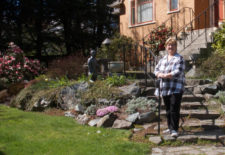Smart Growth & Affordable Housing
by Michele Murphy
If your home is located in such a place that you’re not spending money on transportation to get to work, school, or amenities, then your housing is just that much more affordable.
Affordability is the word of the day, especially when it comes to the biggest expense faced by most of the families in the Capital Region – housing. With the recent release of the Saanich Peninsula Affordable Housing Needs Assessment it’s become clear that affordable housing is not just a downtown problem. Saanich Voice Online continues our conversation with Saanich and the Islands MLA and affordable housing advocate Gary Holman about the situation on the Peninsula.
“Each municipality makes its own contribution to the landscape – forests, agricultural land, riparian areas are treasures that must be protected for a whole number of reasons, not just aesthetic.”
~ Gary Holman, MLA
The affordability needs assessment was done by housing research expert and (now) Executive Director of the Community Social Planning Council, Marika Albert. It was overseen by an advisory committee comprised of Christine Cullham, manager of CRD Regional Housing, Gauthier Holman with representatives from each of the municipal councils.
What the study revealed is that almost 8,000 people on the Peninsula are considered housing insecure. This means that they are paying more than 30% of their gross incomes on rent or mortgage payments and, even more worrying, roughly 1,000 are paying more than 50% of their gross incomes on rent, making these people very vulnerable to homelessness. These numbers don’t include the four WSANEC First Nations and preliminary information from each of the bands indicates the housing crisis for these First Nations is worse than for non-Indigenous.
“It’s clear that something needs to be done. More affordable housing needs to be introduced on the Peninsula,” says Holman.
While housing is being built, it’s not necessarily enough nor the kind of housing that will make a significant difference in the affordability crisis. Over 600 housing units have been built on the Peninsula in recent years but most of these are ownership units and affordable only for higher income households. And even though the three municipalities have contributed over $1 million to the CRD Housing Trust Fund to help build affordable housing throughout the region, none of that funding, until very recently, has gone to the Peninsula. But Holman says that this situation is starting to shift.
Sidney Council has just approved a 56-unit affordable housing project, and several more in other Peninsula municipalities are planned or proposed. The Sidney project, being built by the Greater Victoria Rental Development Society (GVRDS), has established a possible model for others to follow. Through municipal incentives in the form of density bonuses, tax relief, parking variances, plus senior government funding, truly affordable rental housing is being created that will remain affordable over time because of a housing agreement placed on title. The GVRDS project in Sidney will help to establish a useful benchmark for municipalities considering development proposals.
But who and how to build affordable housing isn’t the only issue, where it’s built will makes a difference too.
Holman believes that because of a limited land base, constrained by the Agricultural Land Reserve, parks and environmentally sensitive areas, and the understandable resistance to density increases in neighborhoods, every opportunity to create affordable housing should be taken, particularly for developments involving substantial up-zoning.
Holman, an economist by background, believes that housing agreements are the key to ensuring affordability over the long term. “Simply building more market housing without covenants to permanently break the link with inexorable market forces in one of the most desirable places in the world, means you are on a tread mill that is speeding up over time, and soon you would begin to lose the very special rural character of this place. If simply building market housing were the answer, Victoria and Vancouver would not have an affordable housing problem.”
The needs assessment indicated that while the Peninsula has about 10% of the Capital Region’s population, it only has 5.6% of the social housing stock. Holman feels that the Peninsula and the Capital Region need a bigger, permanent stock of affordable housing, particularly rental housing, to directly benefit low and modest income families, workers and seniors, but also to stabilize overall market housing prices and rents.
An often-overlooked aspect of the affordable housing issue is the role of settlement patterns and public transit. “Keeping communities compact and within walking distance to services and jobs is essential to preserve the rural areas of the Peninsula,” says Holman. Building affordable housing in or near villages, commercial, and industrial areas can help to prevent urban sprawl which helps to support improvements in transit, reduces traffic congestion and greenhouse gas emissions, and enhances affordability. “If you don’t have to drive your car as frequently, or even better, can give up your car because you can easily walk or take the bus to shopping and work, it reduces your costs and increases your disposable income,” notes Holman.
Housing in or near commercial and light industrial areas is happening in all major cities in an effort to bring homes and work closer together, again. Holman believes our goal should be to build housing in or near already developed areas, not to apply a “quota” to each municipality. He explains “Each municipality makes its own contribution to the landscape – forests, agricultural land, riparian areas are treasures that must be protected for a whole number of reasons, not just aesthetic. In the future, these lands will become even more precious. The good news is that by applying smart growth principles, the development of affordable housing does not have to conflict with preserving the very special, rural nature of the Peninsula.”
-30-



[…] SVO covered the release of the assessment in a story in December, 2016 found HERE […]